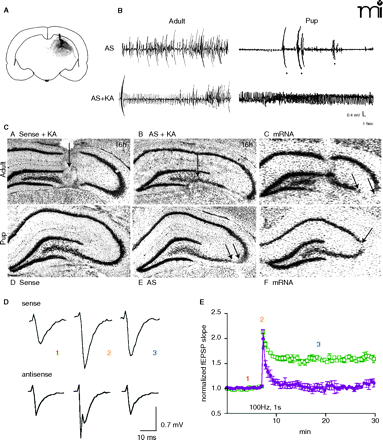
- Institution: Stanford Univ Med Ctr Lane Med Lib/Periodical Dept/Rm L109
- Sign In as Member / Individual
CALCIUM: A Role for Neuroprotection and Sustained Adaptation

GluR2Bknockdown produces age-depenedent epileptogenicity and neurodegeneration. A.33P GluR2B antisense deoxyoligonucleotides (AS-ODN) autoradiography showed the spread and accumulation of our GluR2B antisense injection was limited to the dorsal ipsilateral hippocampus, as indicated by schematic outline of a radiolabeled coronal section. B. In adults, following knockdown of GluR2B expression in the hippocampus alone, EEG recordings showed typical asynchronous activity and normal movement artifacts (upper left trace). Similarly, GluR2B knockdown followed by KA injection did not alter the rhythmical activity in the EEG when compared to KA controls (bottom left trace). In pups, GluR2B knockdown in the absence of KA, produced spontaneous convulsive seizure-like behavior, including body tonus with fore-limb extension and laying on one side; this behavior was associated with high-frequency low-amplitude rhythmical activity of increasing size. Large movement artifacts shown represent intermittent bilateral jerking movements (asterisks) (upper right trace). In GluR2B AS-ODN–treated pups lacking the phenotypic behavior (bottom right trace), a low concentration of KA produced high-frequency rhythmical oscillations associated with tonic-clonic seizure behavior. C. As predicted by the procedure, after GluR2B knockdown and KA-induced seizures, GluR2B mRNA expression was unaltered in CA1 and DG regions but was decreased or lost only within regions of CA3 cell loss at either age [between the arrows in panel (C) and at the arrow in panel (F)]. D. There was a population spike (recruitment of firing) over the excitatory postsynaptic potential (EPSP) after GluR2B expression knockdown compared to that observed in sense-ODN–treated controls (1, baseline; 2, 100 Hz tetanic stimulation; 3, post-tetanus response). E. Long-term potentiation (LTP) was attenuated (3) after GluR2B knockdown where as the induction was unaltered (2). Modified from (75, 76, 142). Reprinted with permission.


